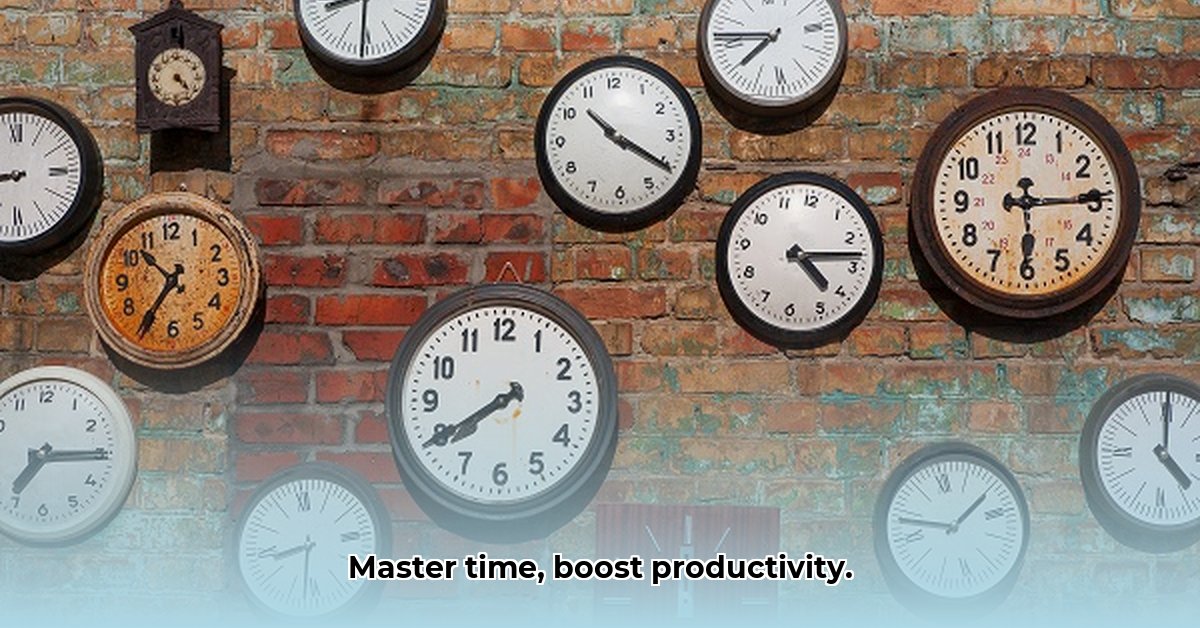Feeling overwhelmed? Like you’re constantly behind? You’re not alone. Many struggle with managing their time, leading to stress and a feeling of perpetual catch-up. But you can take control and accomplish more. This guide explores time management strategies – from simple tricks to structured systems – so you discover what works for you. We’ll guide you through implementation, identify time-wasting habits, and create a personalized, sustainable plan. We’ll cover common challenges and how to adapt as you go. Ready to conquer your to-do list? Let’s begin!
Time Management Theory: Unlock Your Productivity Potential
Ready to stop feeling overwhelmed and start feeling in control? Effective time management isn’t about cramming more into your day; it’s about strategically using your time. Let’s explore popular time management ideas – frameworks, not rigid rules, so experiment! Discover practical strategies to boost your productivity and achieve a better work-life balance.
The Pareto Principle: The 80/20 Rule
Ever notice 80% of your accomplishments stem from 20% of your efforts? That’s the Pareto Principle. Focus on high-impact activities—the ones that truly matter—and prioritize them. Delegate, automate, or eliminate the rest. Think smart prioritization, not just busy work. What are your high-impact activities that yield the most significant results?
Action Plan:
- Brain Dump: Write down everything on your to-do list, big or small, uncensored.
- Impact Assessment: Which 20% of tasks yield 80% of the results? What truly makes a difference to productivity and efficiency?
- Prioritize and Schedule: Schedule crucial tasks for when you’re most alert. Block out this time in your calendar.
The Pickle Jar Theory: Big Rocks First
This analogy is surprisingly helpful: Imagine filling a jar with big rocks (major tasks), pebbles (smaller tasks), and sand (minor tasks). If you start with sand, you’ll never fit the rocks! Tackle your most important tasks first. Get big rocks in, then fit the smaller stuff. It’s about structural prioritization to avoid overwhelm. Do you often find yourself running out of time for important tasks because you focused on smaller ones first?
The Pomodoro Technique: Short Bursts, Big Results
This simple technique involves focused 25-minute intervals, called “pomodoros,” followed by a 5-minute break. Then, repeat! The short breaks are crucial – they prevent burnout and maintain concentration. This structured approach promotes deep work and helps you stay on task. Does the idea of focused work sessions with regular breaks sound appealing to you?
Action Plan:
- Set a Timer: Use a timer (phone, computer, timer) for 25-minute work sessions.
- Focused Work: Dedicate yourself to one task. Minimize distractions. Turn off notifications, close unnecessary tabs, and find a quiet space.
- Short Break: After 25 minutes, take a 5-minute break. Step away from your work, stretch, grab water, or do something unrelated to your task.
- Repeat: Continue this cycle. After four “pomodoros,” take a longer break (15-20 minutes).
The Eisenhower Matrix: Urgent vs. Important
This matrix categorizes tasks based on urgency and importance. It clarifies which tasks to tackle immediately, which to schedule, which to delegate, and which to eliminate. Are you frequently caught up in urgent but unimportant tasks?
| Important | Not Important | |
|---|---|---|
| Urgent | Do this immediately! | Delegate or eliminate. |
| Not Urgent | Schedule these for later. | Eliminate – these are time wasters! |
This visual approach helps you avoid getting bogged down in less important, but urgent, tasks.
Maslow’s Hierarchy and Productivity: The Human Element
While not strictly time management, Maslow’s Hierarchy of Needs reminds us that our well-being directly impacts productivity. Addressing our basic needs (physiological, safety), belonging, esteem, and self-actualization is crucial for long-term success. Ignoring these leads to burnout and decreased effectiveness. Schedule time for self-care, exercise, and activities that nourish your mind and spirit. How well do you prioritize self-care and personal needs in your daily schedule?
Parkinson’s Law: Control Your Time, Control Your Work
This principle highlights how work expands to fill the time available. Setting realistic deadlines forces you to be more efficient. Avoid overly generous time estimates; instead, aim for a tighter timeframe to encourage focused effort. If you give yourself an entire day for a two-hour task, it might well take all day! Do you find that tasks often take longer than expected because you didn’t set a firm deadline?
Identifying Your Time Thieves: Self-Assessment is Key
Be honest: where does your time actually go? Are you constantly checking social media? Getting lost in endless email chains? Identifying time-wasting habits is the first step to overcoming them. Could identifying and eliminating these distractions significantly improve your focus and productivity?
Building Your Personalized System: It’s a Journey, Not a Race
There’s no one-size-fits-all solution. Experiment with these methods. Combine techniques, adapt them to your style, and refine your approach over time. What works for one person might not work for another. Find a system you can stick with.
Adapting and Refining: Embrace the Ongoing Process
Your ideal time management system is not a destination; it’s an ongoing process. Regularly review your system – weekly, monthly, or even daily – to see what’s working and what isn’t. Be flexible and adapt to your changing needs.
Remember, effective time management is a skill that improves with practice. Be patient with yourself, experiment, and enjoy the journey toward becoming the master of your own time.
How to Choose the Best Time Management Method for My Personality
Let’s face it: there’s no single “best” time management method. What works wonderfully for one person might be a disaster for another. The secret lies in how to choose the best time management method for my personality. Your approach should align with your natural inclinations – strengths, weaknesses, and how you prefer to work.
Popular Time Management Techniques
- The Pomodoro Technique: Focused bursts (typically 25 minutes), followed by short breaks. Works well for those who struggle with sustained focus.
- Time Blocking: Schedule specific blocks of time for particular tasks. Ideal for visual planners who appreciate structure and predictability.
- The Eisenhower Matrix (Urgent/Important): Prioritize tasks based on urgency and importance. Helps you focus on high-impact activities.
- Getting Things Done (GTD): A comprehensive system focusing on capturing, clarifying, organizing, reflecting, and engaging with tasks. Best suited for those who thrive on detailed planning and organization and want to increase time awareness.
- The Pareto Principle (80/20 Rule): Identify the 20% of tasks yielding 80% of results. Concentrate your efforts there. This method is great for streamlining workload and provides better task management.
Matching Methods to Personalities
Different personality types tend to respond better to some methodologies. While these are tendencies, not rigid rules, understanding these correlations can aid your decision-making process in how to choose the best time management method for my personality.
A Personalized Approach
Don’t feel confined to a single method. Combine elements that resonate with you. You might use the Eisenhower Matrix for prioritizing and time blocking for scheduling, incorporating Pomodoro for concentrated work sessions, while the 80/20 rule guides your overall strategy. Your personalized system is an evolving process; what works today might need refinement tomorrow. What combination of techniques would best suit your unique style and needs?
Identifying Your Time Wasters
Before building your system, identify your biggest time-wasting culprits. Track your time for a week, noting how you spend each hour. Be honest – are you spending too much time on social media or email? Are unnecessary meetings sucking your energy? Pinpointing these time traps gives you actionable data to optimize your system effectively. What are your biggest time wasters that pull you away from important tasks?
Refining Your System
Create a tailored system based on your personality and the time usage analysis. Start small; don’t try to implement everything at once. Gradually integrate the chosen techniques. Remember, consistency is key. Monitor your progress and adapt your system as needed. Continuous improvement is vital to long-term success in time management and increase productivity. Learn how to improve time management skills through continuous refinement.
Step-by-Step Guide to Creating Your Personalized System
- Self-Assessment: Identify your personality type and work style.
- Time Tracking: Track your time usage for a week to pinpoint areas for improvement.
- Technique Selection: Explore the different time management methods.
- Hybrid Approach: Combine elements from various methods.
- Implementation: Gradually integrate selected techniques.
- Monitoring and Adaptation: Track progress, regularly review and adjust your system and improve prioritization skills.
Effective Time Management Strategies for Remote Teams
Remote teams face unique time management challenges. Communication barriers, distractions at home, and varying time zones can all impact productivity. But with the right strategies, remote teams can thrive.
Communication is
- How To Balance Coaching And Personal Life For Well-Being - January 6, 2026
- Work Life Balance Coach Transforms Stress into Sustainable Well-being - January 5, 2026
- Work-Life Balance Solutions: Strategies for Achieving Personal and Professional - January 4, 2026
















